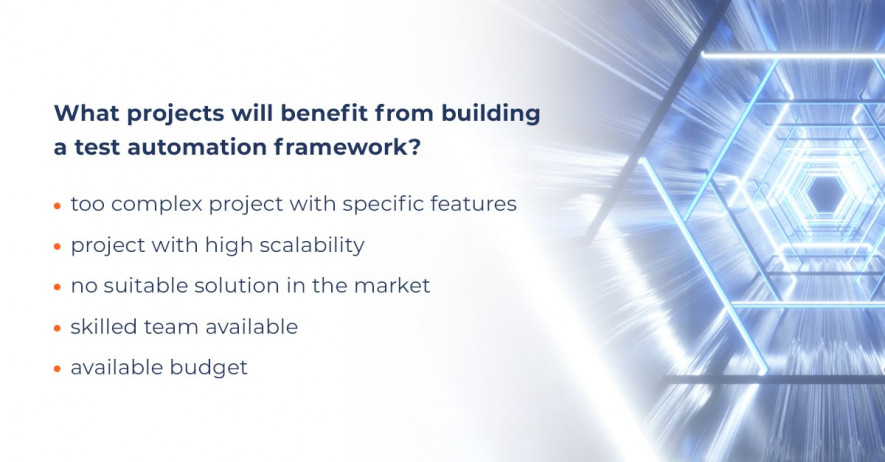- QATestLab Blog >
- Automated Testing >
- Test Automation Framework: To Build Or To Buy?
Test Automation Framework: To Build Or To Buy?

Note: the article was updated in October 2020.
If you want to leverage the power of the test automation framework, two options are available: developing your own or using the existing one solution. Both of them have arguably their own pros and cons. Thus the wrong choice may result in new problems and unexpected monetary losses. So, to build or to buy – which strategy to choose for the test automation framework? In fact, there is no universal answer, and to make real progress, diving into details is a must.
What is the Test Automation Framework?
Before choosing a type of test automation framework, it is highly desirable to clarify what tasks it performs and whether your project requires it. For example, some cases are much easier and cheaper to complete using test automation tools like Selenium, Ranorex, or Appium. Tools are not equal to frameworks, but they are enough to create, run, and store tests.
In turn, frameworks are more powerful solutions that not only do the aforementioned things but also manage them. More precisely, the test automation framework allows executing a larger amount of tests, tracking this process, and generating detailed reports on its basis. Sometimes, projects require a test automation tool, so there is no need to buy or build your own framework.
What are the advantages of the automation framework?
Using a test automation framework has many benefits; the most significant is the opportunity to accumulate better results with less time and effort. Apart from this, it makes code more readable and reusable. You can choose both commercial and open-source instruments from a huge variety of ready automation frameworks. It is not always easy to find a ready tool that will correspond to all the requirements. Even more complicated is to adjust a ready solution to a particular project.
So to build or to buy? Let’s consider two options in more detail.
The buying option (or using free framework)
Be it a commercial or open-source framework, it can bring two major advantages. The first one is you can set up and start using it quickly and effortlessly. For example, if the test code is hosted on GitHub, the test automation framework can create dashboards and run tests in a matter of a few configurations. Another benefit is the opportunity to receive detailed reports and data like charts or graphs generated based on the test being executed.
To select a test automation framework, read the whitepaper, Guide to Test Automation Tools.
The building option
While the buying option is about covering average requirements, the building one is about customization. When you develop your own solution, you get full control over it, and you are not limited to adding new features or removing unnecessary ones. In other words, you adjust the test automation framework directly to the needs of your project and thus can be sure that it satisfies specific and uncommon needs that ready frameworks can’t cover at all.

Drawbacks of building test automation solution
Developing your own test automation solution, you may probably face three core pitfalls. They are time, money, and resources. Let’s view them in more detail.
#1 Time. The development of your own test automation framework is not a one-day activity. It requires much planning, analysis, and development. At the planning stage, you can enumerate the requirements needed for your future project. But they should be real must-haves, not just nice-to-have requirements. After such an analysis, you will probably find out that a solution you require is already available in the market.
#2 Money. For building your own solution, you should have skilled and experienced specialists who will be able to develop such a tool. Also, you should provide your team with all the necessary equipment to develop a framework. It requires investments. That’s why it is worth considering whether you are sure that spent time and money worth profit. Very often, projects can be not so complex and large to require a dedicated automation solution.
#3 Resources. One more case you should consider. What if the head of your team that was engaged in the development of a framework decided to leave the company? What will you do then? You can watch the webinar to know more pros and cons of building and developing test automation frameworks.
Conclusions: Who needs to buy, and who to build?
Building your own test automation framework is a total win if:
- you have a highly specific and complex project
- further development is planned
- enough budget is allocated
- you have skilled specialists
Or you can use a ready automation tool either commercial or open-source one if:
- your project is not too specific
- you have a limited budget
- you have tight timeframes
- you have a QA team of non-technical specialists
To discover more information on software testing, visit our blog. If your project requires testing, get in touch with our team.
Learn more from QATestLab
Related Posts:
- How to automate web testing with manual QA team?
- Top Test Automation Tools to Choose
- The Power of Automated QA in E-Commerce: Speed, Stability, and Success
About Article Author
view more articles
has 5 years experience in management, experience in testing, marketing, sales, business development, manages 15+ active projects, leads team of more than 20 members.
View More Articles







No Comments Yet!
You can be the one to start a conversation.